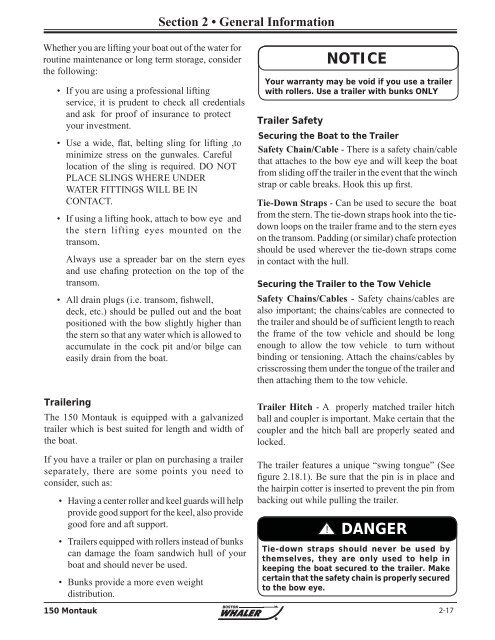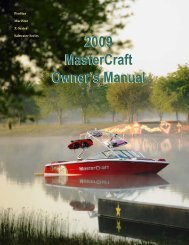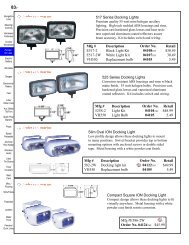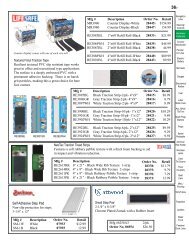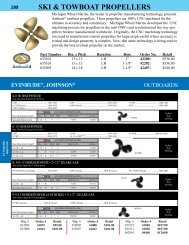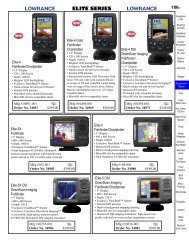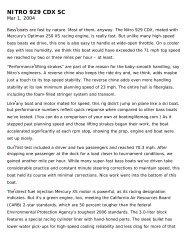notice - Boston Whaler
notice - Boston Whaler
notice - Boston Whaler
Create successful ePaper yourself
Turn your PDF publications into a flip-book with our unique Google optimized e-Paper software.
Whether you are lifting your boat out of the water for<br />
routine maintenance or long term storage, consider<br />
the following:<br />
• If you are using a professional lifting<br />
service, it is prudent to check all credentials<br />
and ask for proof of insurance to protect<br />
your investment.<br />
• Use a wide, fl at, belting sling for lifting ,to<br />
minimize stress on the gunwales. Careful<br />
location of the sling is required. DO NOT<br />
PLACE SLINGS WHERE UNDER<br />
WATER FITTINGS WILL BE IN<br />
CONTACT.<br />
• If using a lifting hook, attach to bow eye and<br />
the stern lifting eyes mounted on the<br />
transom.<br />
Always use a spreader bar on the stern eyes<br />
and use chafi ng protection on the top of the<br />
transom.<br />
• All drain plugs (i.e. transom, fi shwell,<br />
deck, etc.) should be pulled out and the boat<br />
positioned with the bow slightly higher than<br />
the stern so that any water which is allowed to<br />
accumulate in the cock pit and/or bilge can<br />
easily drain from the boat.<br />
Trailering<br />
The 150 Montauk is equipped with a galvanized<br />
trailer which is best suited for length and width of<br />
the boat.<br />
If you have a trailer or plan on purchasing a trailer<br />
separately, there are some points you need to<br />
consider, such as:<br />
• Having a center roller and keel guards will help<br />
provide good support for the keel, also provide<br />
good fore and aft support.<br />
150 Montauk<br />
Section 2 • General Information<br />
• Trailers equipped with rollers instead of bunks<br />
can damage the foam sandwich hull of your<br />
boat and should never be used.<br />
• Bunks provide a more even weight<br />
distribution.<br />
Trailer Safety<br />
Securing the Boat to the Trailer<br />
Safety Chain/Cable - There is a safety chain/cable<br />
that attaches to the bow eye and will keep the boat<br />
from sliding off the trailer in the event that the winch<br />
strap or cable breaks. Hook this up fi rst.<br />
Tie-Down Straps - Can be used to secure the boat<br />
from the stern. The tie-down straps hook into the tiedown<br />
loops on the trailer frame and to the stern eyes<br />
on the transom. Padding (or similar) chafe protection<br />
should be used wherever the tie-down straps come<br />
in contact with the hull.<br />
Securing the Trailer to the Tow Vehicle<br />
Safety Chains/Cables - Safety chains/cables are<br />
also important; the chains/cables are connected to<br />
the trailer and should be of suffi cient length to reach<br />
the frame of the tow vehicle and should be long<br />
enough to allow the tow vehicle to turn without<br />
binding or tensioning. Attach the chains/cables by<br />
crisscrossing them under the tongue of the trailer and<br />
then attaching them to the tow vehicle.<br />
Trailer Hitch - A properly matched trailer hitch<br />
ball and coupler is important. Make certain that the<br />
coupler and the hitch ball are properly seated and<br />
locked.<br />
The trailer features a unique “swing tongue” (See<br />
fi gure 2.18.1). Be sure that the pin is in place and<br />
the hairpin cotter is inserted to prevent the pin from<br />
backing out while pulling the trailer.<br />
R<br />
NOTICE<br />
Your warranty may be void if you use a trailer<br />
with rollers. Use a trailer with bunks ONLY<br />
! DANGER<br />
Tie-down straps should never be used by<br />
themselves, they are only used to help in<br />
keeping the boat secured to the trailer. Make<br />
certain that the safety chain is properly secured<br />
to the bow eye.<br />
2-17


